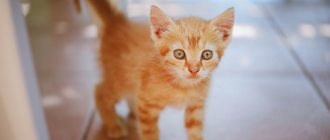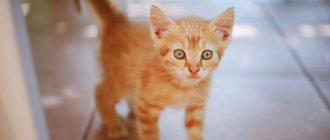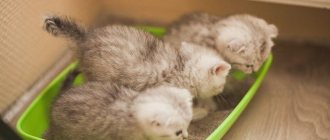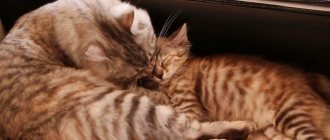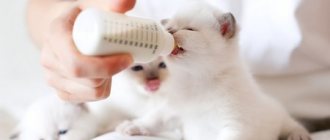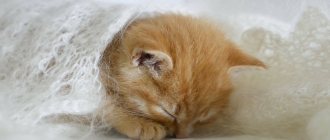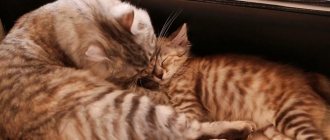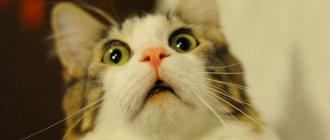During the period when kittens are born, the owner bears the responsibility of caring not only for the mother cat, but also for her fragile children. It is necessary to prepare a comfortable and safe place where newborns will be. And there are even more obligations when babies try to take their first steps. Accordingly, you need to know about how they grow and develop, when kittens begin to walk, and what problems may arise in connection with this. This will be discussed in this article.
Details of the development of cat paws
Cat's paws require special attention, since they are an important organ not only for movement, but also for the animal's senses.
A little about the structure of the limbs
The cat's front paws do not have a solid connection to the skeleton, but are connected to it through elastic and strong tendons. This anatomical feature is called a floating shoulder. Thanks to this, the animal has the ability to smoothly descend when jumping from a height. And that is why cats are able to walk quietly and imperceptibly, as if they were swimming, taking a sliding step.
Cat paws, at first glance, soft, can cause injury to the offender
The forelimbs of pets have five fingers. The claws grow from the last phalanx of the finger and are released only during hunting, fighting, or for climbing surfaces. The rest of the time they are hidden in the phalanges, and the paws are soft pads.
For your information! The exception is the first finger, which is located a little further from the rest. The claw on it does not retract.
As for the hind limbs, they, unlike the front ones, are rigidly attached to the sacrum, the paws are stronger. This is due to more stress on the back of the body. The animal strongly uses these paws when running or jumping. In this case, they serve as a kind of push and support for him. There are four toes on the hind legs.
Note! Some types of cats have a deviation in the number of fingers on their limbs - polydactyly or oligodactyly, when there are more or less fingers than normal. These defects are inherited.
Functions of cat paws
Cat paws are quite versatile. During evolution, they acquired the ability to perform various functions, thanks to which the animal managed to survive and adapt to living conditions:
- moving, touching, clinging to objects, climbing. Cats' paws are incredibly flexible, thanks to which animals can climb a tree or other tall object with enviable ease and move deftly along it. This allows them to be successful hunters;
- shock absorption when jumping, thanks to which they smoothly push off from the surface and also land on it;
- caring for your fur. They wash with their paw the places that their tongue cannot reach (muzzle, ears);
- tactile function. Check items for possible danger;
- hunting and self-defense. Sharp claws in their paws allow them to deftly catch prey and also defend themselves from enemies;
- food and drink. You can often see cats catching food and water with their paws. The reason for this may be a not very comfortable bowl, which the pet touches with its whiskers. In this regard, the animal experiences discomfort and uses its limbs;
- relaxation, relaxation. Moving your fingertips over the surface when the cat is calm and content;
- communication. Thanks to the sensitivity of the paws and the characteristic secretion of the glands that they produce.
Important! Since an animal's paws perform a number of vital functions, they must be subject to careful care and attention. The owner should inspect them more often to identify scratches, cuts, infections and foreign objects.
Cats' paws are their means of communication with humans
How does pregnancy go in cats?
On average, pregnancy in cats lasts 9 weeks and how soon a cat gives birth depends on the number of kittens she is carrying. The more there are, the sooner the birth will take place. Typically, all cats, even rare breeds, tolerate this condition completely normally and do not require special veterinary supervision. Their belly becomes noticeable after 3-4 weeks, especially if the cat is smooth-haired.
2-3 weeks before giving birth, you can feel the kittens starting to move in her stomach. At first, you can understand that there is movement in the stomach only by placing your palm on it. The first movements are rare - you will have to keep your hand pressed tightly for several minutes before you feel them. After a week, the belly is already moving constantly and, if the fur is short, this movement can be seen even without putting your hand to the cat’s belly - he just walks around.
This activity has a simple explanation. Firstly, a cat usually has several kittens; if one is sleeping, the second can toss and turn in its amniotic sac. Secondly, kittens, although they are born blind, compared to a child, are much more adapted to life - they begin to crawl immediately. Therefore, before giving birth, kittens ready to get out into the world move quite a lot.
The main stages of development of the motor system
When do kittens start going to the toilet on their own?
Developing the skills of a small kitten to walk confidently and run quickly takes place in several stages:
- A newly born kitten is helpless because it cannot not only walk, but also see and hear. They can only smell, since the sense of smell is highly developed.
- At the age of 1 day to five days, when the kittens’ eyes are not yet open, they try to move by crawling on their stomachs. A keenly developed sense of smell helps them move in the right direction. They find their mother by smell, trying to get closer to her, moving their weak paws along the floor.
- At the age of 5-10 days, kittens are already better oriented and quickly find the cat by smell, trying to actively work with their limbs, crawling on the floor.
- Between one and a half to two weeks, the babies' eyes open and they rise to their forelimbs. During the same period, the hind legs develop.
- Already at the age of two weeks, babies rise and stand on all their legs, trying to repeat everything after their mother, including walking. During this same period, it is very important to toilet train them. The babies' first steps are still uncertain: they stand on their paws for the first time and at the same time sway from side to side, falling onto their sides. In fact, this is the period of the first exercises to train muscles and joints.
- Three weeks of age is the period when kittens’ limbs finally develop, they no longer begin to crawl, but to walk, and even try to run and make their first attempts at jumping.
- At one month of age, the animal’s movements have already been honed and they are confident that they can fully control their body. During this period, kittens actively play with each other, run and jump.
Diet recommendations according to the age of the kitten
A 2-4 month old kitten has already developed sharp teeth; he should be able to eat from a bowl himself. Intensive growth and development of the animal requires a balanced and varied diet. The basis of the diet is lean meat, vegetables (preferably boiled) and porridge. The cereal should be boiled in a large amount of water so that the resulting porridge has a liquid consistency. Half of the diet consists of low-fat sour milk.
From 4 to 6 months, the animal’s body actively builds and strengthens muscle mass. The basis of the diet is beef and chicken, cut into small cubes and offal. Fermented milk products are allowed, but in smaller quantities. Cow's milk should be removed from the diet. Porridges are cooked with less water to make the consistency thicker. It is recommended to introduce boiled and raw vegetables, cucumbers, and zucchini into the kitten’s diet.
The animal's nutrition expands from 6 months. All products should be cut into large cubes, and porridge should be cooked more crumbly. It is during this period that it is recommended to include industrial feed in the diet, according to the age category of the animal.
When do kittens start walking instead of crawling?
When do kittens start eating on their own?
For some time after birth, it is still quite difficult for a kitten to move: its legs are weak, and its eyes still cannot see. However, closer to 2.5-3 weeks, babies already develop vision and hearing, they go to the tray on their own, can eat on their own and do without their mother, and at the same time they try to move on their legs. Naturally, their first steps are still uncertain and weak. But after a week, the movements become more dexterous, the steps are confident, and the kittens happily jump and run.
Note! The time frame for when, how and how long kittens walk does not depend on the breed of the pet. This is affected only by his physical health and proper nutrition.
The kitten's first steps are still weak and uncertain
When does a baby first stand on its paws?
The kitten tries its paws at the age of 2 weeks
. In general, the development of kittens of all breeds occurs the same. However, some experienced breeders find a difference and say that this happens differently in different breeds. Girls are usually 1-2 days ahead of boys in development, and short-haired breeds develop slightly faster than long-haired ones. In total, the kitten will try to stand on its paws when it is 10-14 days old, and will fully stand and run in about 20 days.
If the development of a kitten is noticeably delayed compared to the rest of its litter or differs from the general framework, you need to contact a veterinarian. The development of the kitten in the first month determines its entire future life. A specialist will help correct nutrition or other causes of developmental delay.
Problems in limb development
A conscientious breeder or simply a good owner must monitor whether the kittens are developing correctly and take care of the completeness and safety of the conditions in which they live and grow.
When kittens open their eyes: how many days after birth
If by the end of 3 weeks the baby does not stand on its paws, then this may be a serious reason to seek help from a veterinarian. After all, weak limbs and accompanying pain are signs of certain pathologies, such as:
- musculoskeletal disorder;
- hip dysplasia;
- rickets;
- kidney diseases;
- oncological diseases;
- poisoning;
- various injuries.
Important! If any problems are detected, immediate consultation with a specialist will be required. There is no need to wait until the baby grows up, since wasting time will only aggravate the problem and harm his health.
Rickets in a kitten
Feeding a kitten deprived of maternal care
Unfortunately, there are situations when a kitten, for various reasons, is left without the care of its mother cat. In this case, the owner’s main task is to provide the newborn baby with the correct and timely diet. Feeding kittens left without a cat should be carried out in consultation with a veterinarian, who will determine the correct feeding schedule and tell you how to replace cat's milk with cow's milk without harm to the baby's health.
If the veterinarian is unavailable for some reason, here are a couple of recipes for preparing food for your pet:
- add 15 g of whole milk powder and 2.5 g of dry yeast to 50 g of cow's milk;
- add egg yolk and 4 teaspoons of granulated sugar to 0.5 liters of concentrated milk;
Scottish Fold kitten Until one month of age, kittens require 8-10 meals a day at equal intervals
It is important that the temperature of the milk is about 37 degrees, and the process of feeding the pet should be carried out using a pipette
When the baby is 3 weeks old, you can replace the pipette with a bottle with a nipple. Also, we must not forget about the need for a light massage of the tummy immediately after eating, this stimulates the work of the digestive system that has not yet become stronger.
Under no circumstances should overfeeding be allowed. You can determine that the baby is hungry by the shrill squeak that the kitten will make while crawling around its place in search of its mother.
Features of caring for kittens that have just begun to walk
A caring owner understands what problems kittens may have when they begin to take their first steps. After all, many obstacles and dangers await them on this unknown path. Therefore, it is necessary to take care of their safety by observing the most common requirements:
- remove away all objects that could cause injury to the baby’s legs. These can be heavy stools and chairs that can fall on a kitten, a flower pot, or sharp, small objects, as well as wires, various chemicals (washing powders, cleaning products, etc.);
- make sure that the kitten does not jump on high surfaces at first, as this can harm weak legs, remove everything from the eyes that might attract it, tie up the curtains;
- If the flooring in your house is slippery, you should at least temporarily lay a short-pile carpet on it. This will protect the still uncertainly moving kitten from slipping and spraining its paw. The place for the small creature to move must be adapted to its needs;
- do not allow anyone to pick up a still fragile creature, especially children, who can harm the baby with their careless movements. It is necessary to explain to them how dangerous and painful this can be for the kitten. When the cat gets a little older, you need to teach children to hold it correctly in their hands;
- You should also be careful when moving around the room, because the baby can come up quietly and unnoticed, and there is a risk of stepping on his foot or pushing him unsuccessfully;
- Transportation during this period is also undesirable, since the musculoskeletal system has not yet fully formed. If it is necessary to show the kitten to a veterinarian, it is better to call one to your home. Visiting an animal clinic for children also means that there is a high probability of contracting an infectious disease.
A kitten needs to learn to walk in a safe environment.
When the kittens grow up and get stronger, they begin to explore the world. Having learned to walk, they encounter various obstacles on their way that can injure the animal. Only a responsible owner can create more comfortable conditions for them and keep them safe. Having shown his participation in the physical development of the baby, he will receive healthy and active pets in the future.
Does a kitten need a separate sleeping place?
Usually the cat chooses its favorite places to rest, so you should take a closer look at your pet’s habits and place a lounger exactly where he most often likes to take a nap. This is also convenient for the owner himself - it is easier to remove cat hair from only one place, and not from all surfaces in the house.
But sometimes it happens that kittens fall asleep in the most inappropriate places.
Do not rush to transfer the baby to his lounger. Perhaps he is still wondering if he likes his bed. If the kitten ignores the sleeping place specially purchased for it, you will have to give in to the wayward cub and allow it to sleep wherever it pleases.
Ragdolls
Ragdoll takes any pose that the owner chooses for him.
Ragdolls are one of the most popular family breeds. They were specially bred to be affectionate, obedient and patient with their owners. These cats are suitable for families with children, especially small children.
The unique ability of these pets is to remain completely relaxed even during a tight hug. It’s not for nothing that the literal translation of their breed sounds like “rag doll.”
